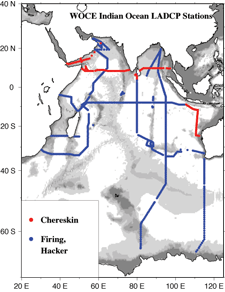
 |
WOCE Indian Ocean Expedition |
Teresa K. Chereskin |
The World Ocean Circulation Experiment (WOCE) Indian Ocean Expedition was an ambitious survey designed to sample the entire Indian Ocean within a single year and required the collaboration and coordination of many investigators worldwide. The survey sampling included conductivity-temperature-depth-oxygen (CTD-O2) measurements, nutrient measurements, and direct velocity observations from shipboard and lowered acoustic Doppler current profilers (ADCP). The observations were made at closely-spaced station locations as shown on the map (above left). Other components of the study included surface-layer drifters, subsurface floats, and moored arrays. The expedition began in late 1994 and ended in early 1996. Many of the results of the experiment have now been published in two special sections of Geophysical Research Letters (Volume 24, nos. 21 and 22) and in a pair of special volumes (49 and 50) of Deep Sea Research Part II. My focus was on the tropical Indian Ocean: the Arabian Sea, the Bay of Bengal, and the Indonesian Throughflow (red lines shown on the survey map).
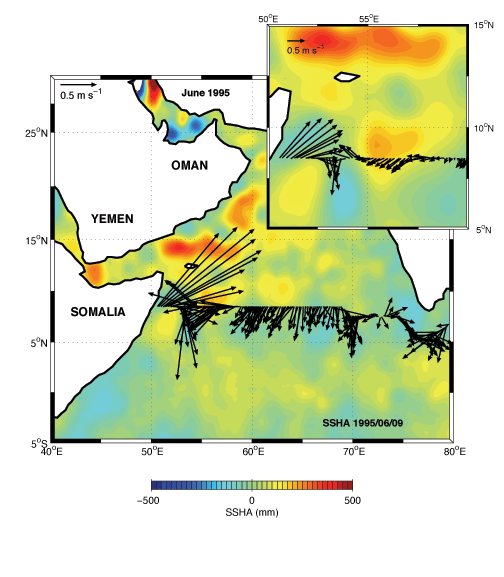
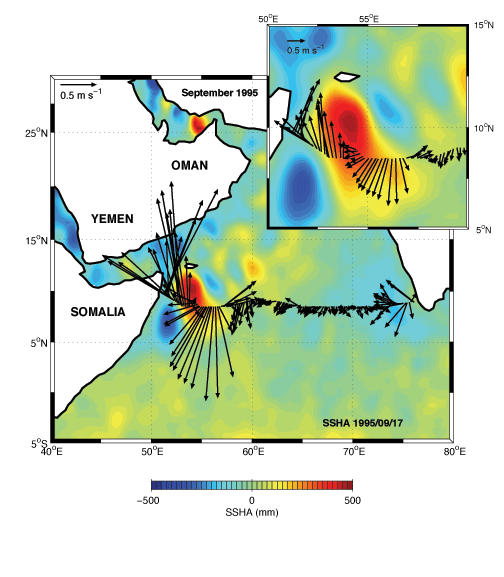
Figure 1: Currents at 22 m during June (left) and September (right) 1995 overlain on sea surface height anomaly maps from AVISO. The Somali Current is not evident in the June section, when a shallow anticyclone is present at the coast, possibly an early stage of the Great Whirl. The Somali Current in September is a strong and narrow jet flowing over the continental shelf and slope with speeds in excess of 150 cm/s. From June to September the Great Whirl, the 500 km wide anticyclonic eddy located between 52°E and 57°E reached its maximum size. Also noticeable is a reduction in the southward Ekman transport across the section from June to September.
The WOCE lines sampled the Arabian Sea at the onset (June) and the wane (September) of the 1995 monsoon. The Arabian Sea undergoes a dramatic seasonal cycle due to the monsoons. As a result, the wind-driven Ekman transport, the western boundary current (Somali Current), and the interior Arabian gyre all reverse seasonally. There are many interesting phenomena associated with the monsoons, but one of the most intriguing is the phenomenon of Arabian Sea cooling during the summertime southwest monsoon. At a time when the net surface heat flux is at a maximum and is directed into the ocean, the Arabian Sea experiences a rapid heat loss due primarily to the export of heat via the strong southeastward Ekman transport. Since the Ekman transport is large, carries the warmest water, and reverses seasonally, it can potentially reverse the sign of the net seasonal heat transport of the Arabian Sea. Analysis of global eddy-resolving models suggest that the annual cycle of heat flux in the northern Indian Ocean is dominated by the Ekman temperature flux in the Arabian Sea. The Ekman temperature flux is sensitive to assumptions about the depth of penetration of the wind-driven flow, and therefore the Ekman depth as well as the Ekman transport are important issues for the meridional overturning circulation of the Indian Ocean.
The deep penetration of the wind-driven flow at low latitude (to the top of the pycnocline) has now been observed from WOCE surveys in all three major oceans (Chereskin and Price, 2001). This deep penetration has its largest influence on the Ekman heat and salt transports in the Arabian Sea, despite being the smallest of the basins, because of the strong monsoon forcing. The Ekman layer temperature calculated from the 8°30'N section across the Arabian Sea in September 1995 was 1.1°C colder than surface values (Chereskin, et al., 2002). The directly measured ageostrophic flows and their associated heat and freshwater fluxes were incorporated into an inverse model for the Arabian Sea (Beal et al., 2003) used to diagnose the total top-to-bottom heat and freshwater budgets. Also significant to the budget calculation was the deep penetration of the Somali Current and Great Whirl (Beal and Chereskin, 2003) and a gyre-scale reversal in the deep circulation in the Somali Basin between June and September (Beal et al., 2000) observed using LADCP measurements.
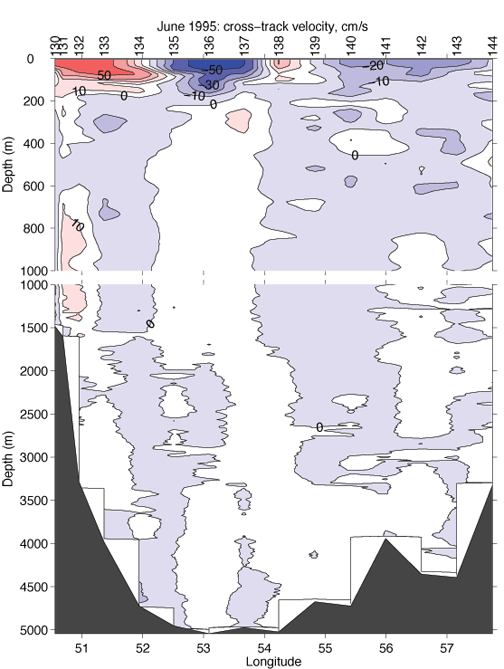
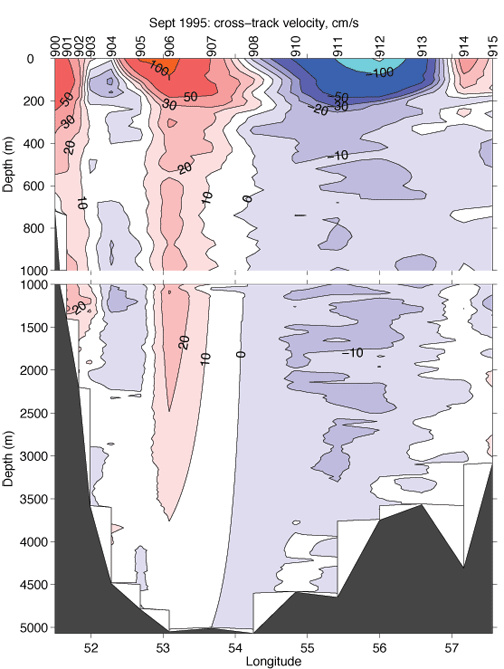
Figure 2: Cross-track currents from shipboard and lowered ADCP across the Somali Current and Great Whirl during June (left) and September (right) 1995. In June there is no evidence of a Somali Current at the coast. A small and shallow anticyclonic eddy is present, possibly the early stage of the Great Whirl. In September, the Somali Current and Great Whirl are both fully developed. The highest measured velocities iin the Somali Current (over 150 cm/s) were found at the surface over the continental shelf (Fig. 1) and are not shown on the above section which begins at the continental slope. There is significant northeastward flow in the Somali Current to about 2000 m depth. Currents in the Great Whirl extended to 3500 m depth.
The Indonesian Throughflow is the transport of warm and fresh Pacific waters into the Indian Ocean via the Indonesian seas, and it has a major impact on the mass, heat, and freshwater budgets of the South Pacific and Indian Oceans. The main new result from analysis of the WOCE lines in the Indo-Australian Basin is the energetic mesoscale circulation. Our current view of the Throughflow is that it has 3 primary components: a shallow surface Ekman flow, an advection by nonlinear Throughflow eddies, and a mean geostrophic component. The high resolution shipboard ADCP and the full-depth lowered ADCP vector velocities provided a valuable description of the Ekman and mesoscale eddy field in the Throughflow region at the time of the WOCE surveys (Sprintall, et al., 2002).
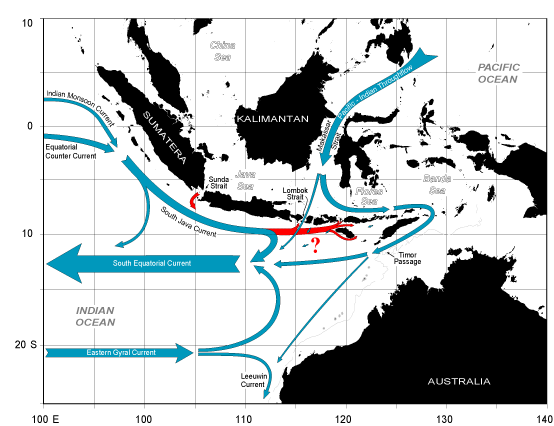
Figure 3: Schematic of the Indonesian Throughflow.
This work was supported by NSF grants OCE94-13174 and OCE99-06776
Chereskin, T. K.,W. D. Wilson, H. L. Bryden, A. Ffield, and J. Morrison, 1997. Observations of the Ekman balance at 8°30'N in the Arabian Sea during the 1995 southwest monsoon. Geophys. Res. Lett., 24(21),2541-2544.Abstract
Beal, L. M., R. L. Molinari, T. K. Chereskin, and P. E. Robbins, 2000. Reversing bottom circulation in the Somali Basin. Geophys. Res. Letters, 27,2565-2568.
Chereskin, T. K., and J. F. Price, 2001. Ekman Transport and Pumping. In Encyclopedia of Ocean Sciences, J. H. Steele, S. A. Thorpe, and K. E. Turekian, eds., 809-815, Academic Press, 3500 pp.Abstract
Chereskin, T. K., W. D. Wilson, and L. M. Beal, 2002. The Ekman temperature and salt fluxes at 8°30' in the Arabian Sea during the 1995 southwest monsoon, Deep-Sea Res. II, 49, 1211-1230.
Sprintall, J., S. Wijffels, T. K. Chereskin, and N. A. Bray, 2002 The JADE and WOCE I10/IR6 Throughflow sections in the southeast Indian Ocean. Part 2: velocity and transports. Deep-Sea Res. II, 49, 1363-1389.
Beal, L. M., T. K. Chereskin, H. L. Bryden and A. Ffield, 2003. Heat and freshwater fluxes of the Arabian Sea at the onset and wane of the southwest monsoon. Deep-Sea Res. II, 50, 2049-2076.
Beal, L. M. and T. K. Chereskin, 2003. The volume transport of the Somali Current during the 1995 southwest monsoon. Deep-Sea Res. II, 50, 2077-2090.